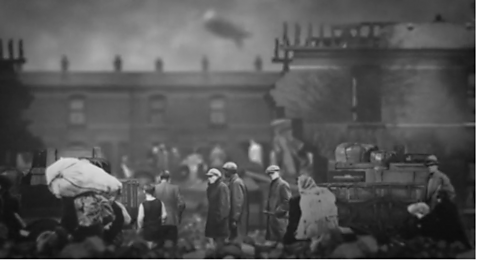Animation scripted by Dr Jonathan Bardon
The bombers return
The skies were clear and the moon was full, when over 200 German bombers approached Belfast on 4 May 1941. Some hugged the County Down coast, whilst others flew past Carrickfergus on their way to Belfast Lough.
Their target was a poorly defended Belfast on a night that became known as the ‘Fire Blitz’.
At ten minutes past midnight, Belfast's sirens sounded a red alert. Over the next few hours, the Germans dropped almost 100 000 incendiary bombs and 237 tons of high explosives. They were even able to fly beneath the protective barrage balloons, increasing their accuracy.
The main targets were industrial - Belfast's harbour, aircraft factory and shipyards were all vital to war production. The Germans got the prize of sinking three ships under construction. They also badly damaged two thirds of Harland & Wolff and Short Brothers.
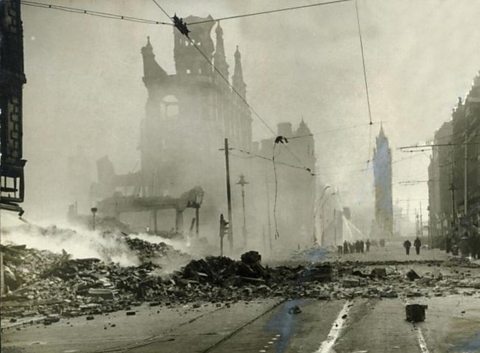
A picture of descruction
Property suffered, but so did people. Many of the workers from east Belfast lived in the congested houses surrounding the shipyards and, inevitably, these could not escape damage from the devastating blasts. The area around Dee Street and the Newtownards Road suffered particularly badly, with few dwellings left unscathed
The death toll was 191, and by now over half of Belfast's houses had been destroyed. Over 300 people, many from the neighbouring Shankill area, took refuge in Clonard Monastery, as residents put aside their religious differences to support one another.
This raid also caused damage to the city centre at High street and St Anne’s Cathedral. Many buildings in the area, now known as the Cathedral Quarter, still bear evidence of bomb damage from this raid.
Luftwaffe crews reported a "picture of destruction none of us will forget". In fact, one fireman from Londonderry, on his way to assist the rescue effort, could see Belfast burning from as far away as the Glenshane Pass.
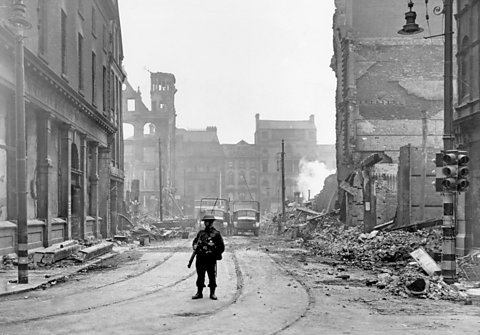
An eyewitness in the sky
A German war correspondent, Ernst von Kuhren, flew with one squadron. He broadcast his impressions on German radio when he got back -
“I could not believe my eyes … we stared silently into a sea of flames such as no one had seen before. Here are the large shipbuilding yards. Here the English had concentrated an important part of the war industries because they felt themselves safe, far up in the north, safe from the blows of the German air force. This has come to an end.”
 Image source, PRONI
Image source, PRONIFlight, fear and fallout
The Belfast Blitz ended on 6 May 1941 when several German bombers struck the city after breaking off from a raid on the River Clyde.
Although the bombs had stopped, the impact of the Blitz continued to be felt. By the end of May 1941, 220 000 people had left Belfast.
However, 150 000 remained in a shattered city. Still lacking proper protection and adequate air raid shelters, living in constant fear of another attack.
For some it was too much. Julia Walsh from County Mayo had been working at a school in Belfast. She wrote a resignation letter to her principal stating that, “I cannot possibly face the strain of another term in Belfast under present conditions.”
The mood did at least stifle any sectarian tensions, with Protestants and Catholics united in anger at the government's inept preparations and complacent attitude.
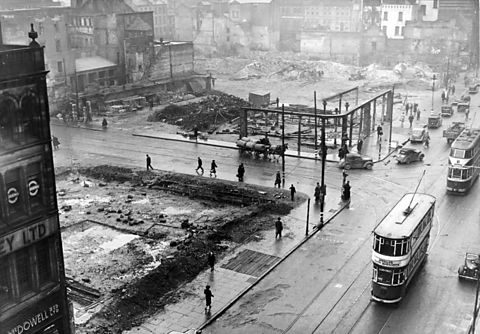 Image source, PRONI
Image source, PRONIMore on The Belfast Blitz
Find out more by working through a topic
- count1 of 4
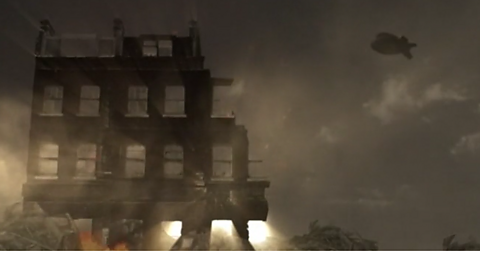
- count2 of 4
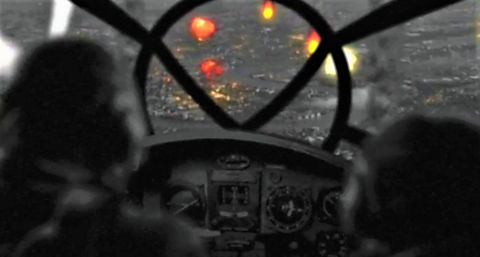
- count3 of 4
